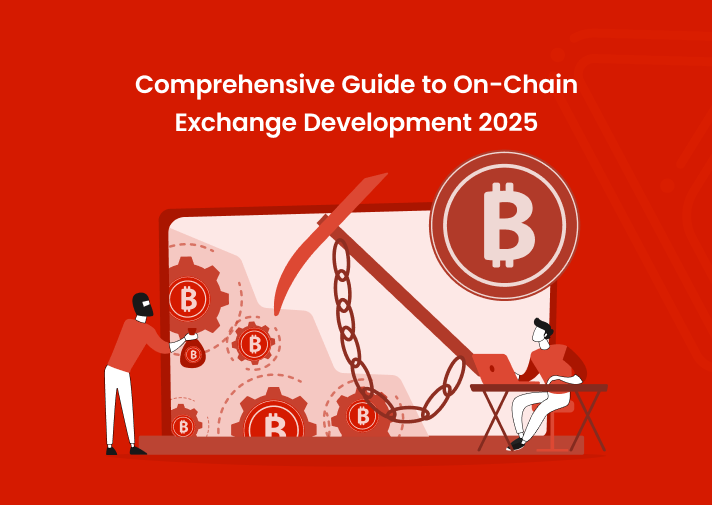Cryptocurrency is growing quickly. Many businesses want to make safe and easy platforms for trading. One way to do this is by using On-Chain Exchange Development. With DeFi becoming more popular, building an on-chain exchange is a great way to offer safe and clear trading.
This guide will explain On-Chain Exchange Development in 2025. We will look at its key parts, features, and how it can help your business. We will also show you how to build an on-chain exchange that is safe, easy to use, and works well.
What is On-Chain Exchange Development?
On-Chain Exchange Development means creating an exchange where all trades happen directly on the Blockchain. Unlike regular exchanges, which use third parties, on-chain exchanges store all trades on the blockchain. This makes the platform safer, clearer, and harder to change after it happens.
Why Do We Need On-Chain Exchange Development?
More people want Decentralized Finance (DeFi) solutions. Here’s why On-Chain Exchange Development is important:
- Security: On-chain exchanges are safer. There are no third parties to hack or steal funds.
- Transparency: Every trade is shown on the blockchain. This makes it easy for anyone to check.
- Control: Users keep full control of their assets. In centralized platforms, third parties manage funds.
Centralized vs. Decentralized Exchanges
| Feature | Centralized Exchange (CEX) | Decentralized Exchange (DEX) |
|---|---|---|
| Control of Funds | Managed by third parties | Users keep control |
| Security | Can be hacked | Very secure because it is decentralized |
| Transaction Speed | Fast due to centralized control | Can be slower due to blockchain speed |
| Liquidity | High liquidity | Low liquidity but improving |
| Regulation | Regulated by authorities | Often not regulated |
It could combine the good things from both centralized and decentralized exchanges in the future.
Why is 2025 the Best Time to Start Your On-Chain Exchange?
2025 is the perfect time to start your on-chain exchange because:
- DeFi is Growing: The DeFi market is getting bigger. Building an on-chain exchange fits with this growth.
- Better Technology: Blockchain technology, smart contracts, and layer-2 solutions have improved. It is now easier to build on-chain exchanges.
- Clearer Rules: Governments are starting to make rules for blockchain platforms. This makes it safer to start your exchange.
- More Demand: People want secure and clear platforms. The demand for on-chain exchanges is growing.
Key Parts of On-Chain Exchange Development
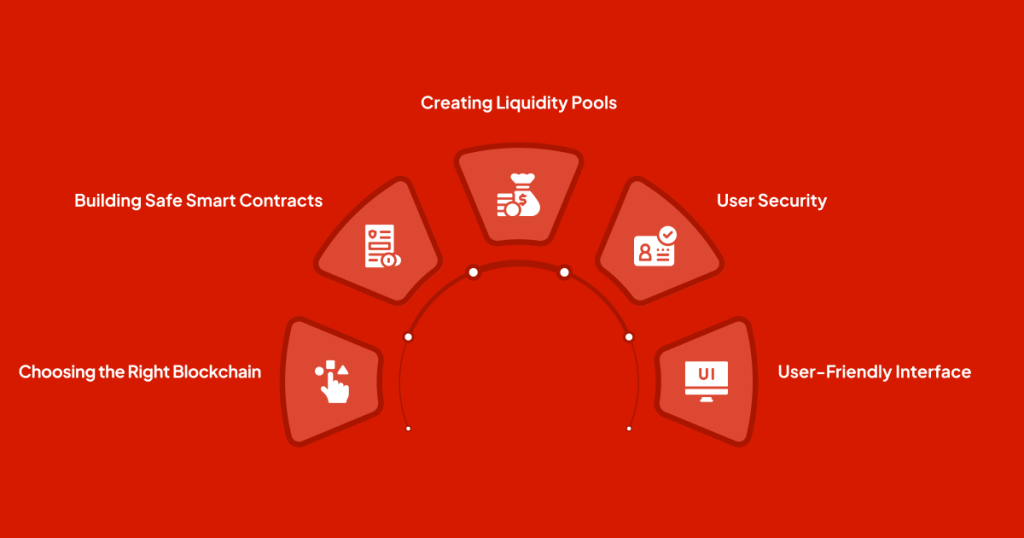
When building an on-chain exchange, you need to focus on a few key parts:
- Building Safe Smart Contracts
Smart contracts are needed to control trades. They make sure that everything happens correctly. These contracts should be safe from hacks. They also need to handle more trades as your platform grows. - Creating Liquidity Pools
Liquidity is very important for exchanges. Liquidity pools let users add their funds to the platform. This helps the exchange run smoothly. It also makes sure that people can trade without delays. - User Security
To protect users, your platform needs good security. This includes two-factor authentication (2FA), multi-signature wallets, and regular security checks. Always test your smart contracts for problems. - User-Friendly Interface (UI)
Make the platform easy to use. The design should be simple and clear. Whether on desktop or mobile, users should be able to find everything easily. A good UI will keep users happy. - Choosing the Right Blockchain
Pick the best blockchain for your platform. Some good blockchains are:
- Ethereum: Good for smart contracts. Used in DeFi.
- Binance Smart Chain (BSC): Faster and cheaper than Ethereum.
- Solana: Fast with low fees.
Key Features of an On-Chain Exchange
An on-chain exchange development should have these important features:
- Liquidity Solutions
Make sure there is enough liquidity so trades happen smoothly. You can use liquidity pools and automated tools to help with this. - User Control Over Assets
On-chain exchanges let users keep control of their funds. Unlike centralized exchanges, where funds are stored on the platform, users store their funds in their own wallets. This makes the platform safer. - Strong Security
Use extra layers of security to protect users’ funds. This includes multi-signature wallets, regular audits, and real-time monitoring. - Real-Time Trading Data
Give users real-time data like price charts, order books, and transaction history. This helps them make better decisions when trading. - Fast and Low-Cost Transactions
Make sure transactions are quick and cost little. You can use Layer-2 solutions or pick a blockchain with fast transactions and low fees.
How to Build an On-Chain Exchange Development?
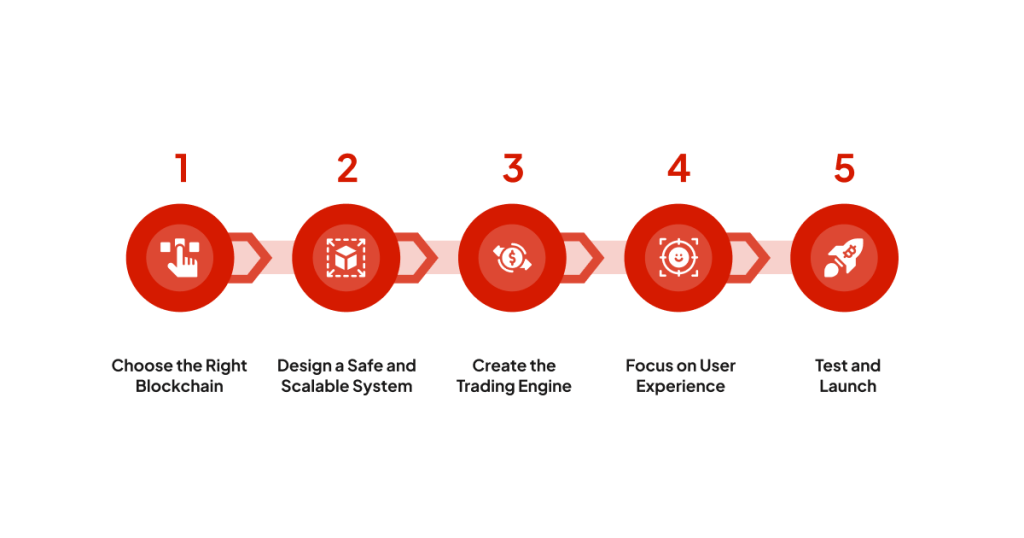
Building an on-chain exchange takes careful planning. Here are 5 steps to guide you:
- Choose the Right Blockchain:
- Pick a blockchain that fits your needs (speed, fees, scalability).
- Check if the blockchain has good community support.
- Make sure it works well with smart contracts.
- Pick a blockchain that fits your needs (speed, fees, scalability).
- Design a Safe and Scalable System:
- Build a system that keeps users safe.
- Make sure it can handle many users and trades.
- Use decentralized liquidity solutions to manage liquidity.
- Build a system that keeps users safe.
- Create the Trading Engine:
- The trading engine helps match buy and sell orders.
- It must work quickly, even when many people are trading.
- Add automated tools to make the trading process faster.
- The trading engine helps match buy and sell orders.
- Focus on User Experience:
- Build an easy-to-use platform with a simple design.
- Make sure it works well on desktop and mobile.
- Make sure it is easy to navigate for new and experienced traders.
- Build an easy-to-use platform with a simple design.
- Test and Launch:
- Test everything before launching. This includes security checks and performance tests.
- Get feedback from users to fix any problems.
- After testing, launch the platform for everyone to use.
- Test everything before launching. This includes security checks and performance tests.
Combining Cryptocurrency Exchange, White Label Exchange, and NFTs in On-Chain Exchanges
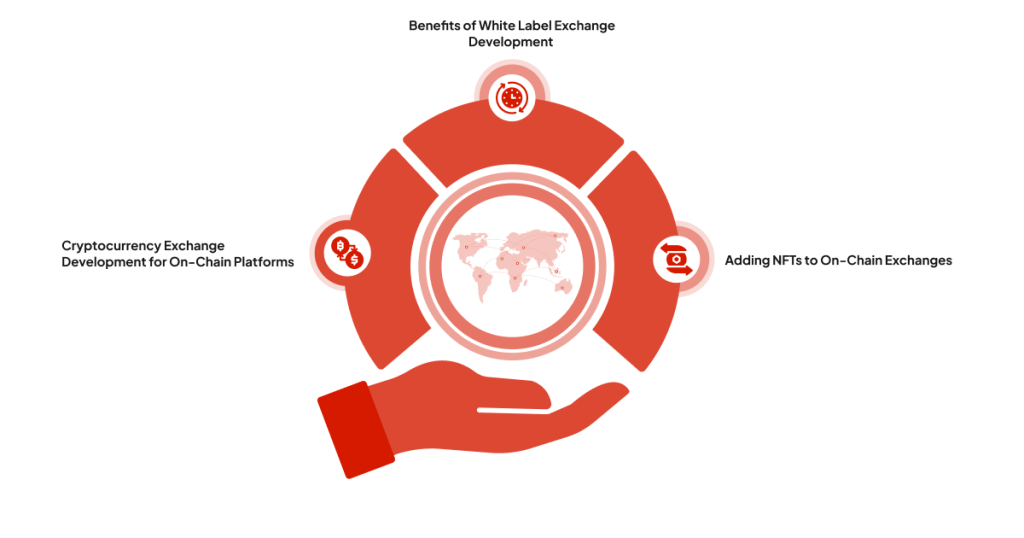
Building an on-chain exchange can be better with Cryptocurrency Exchange Development, white label exchange development, and NFTs. Here’s how:
1. Cryptocurrency Exchange Development for On-Chain Platforms
- It creates a secure space for users to trade directly on the blockchain.
- It makes the exchange transparent and builds trust among users.
- Users from anywhere in the world can access the platform with lower transaction fees.
2. Benefits of White Label Exchange Development
- White Label Exchange Development provides a ready-made solution, saving time and cost.
- You can easily customize the exchange to fit your brand and needs.
- It allows for faster market entry without building from scratch.
3. Adding NFTs to On-Chain Exchanges
- NFTs are unique digital assets like art and collectibles that users can trade.
- They bring new markets to your exchange, attracting different kinds of users.
- By adding NFTs, you offer an exciting trading option that can boost user engagement.
Challenges in On-Chain Exchange Development
Building an on-chain exchange is not always easy. Here are some challenges:
- Scalability: It can be hard to handle lots of trades at once. You need to find ways to scale your platform.
- Transaction Costs: Blockchain fees can go up, especially when the network is busy. Make sure to reduce costs.
- Liquidity Issues: New exchanges might not have enough liquidity. This can make it harder for people to trade.
- Security Risks: On-chain exchanges are safe, but they can still be hacked if not well protected.
- Regulations: Laws for crypto exchanges are changing. Stay up to date with rules.
How Mobile Apps Enhance On-Chain Exchange Development
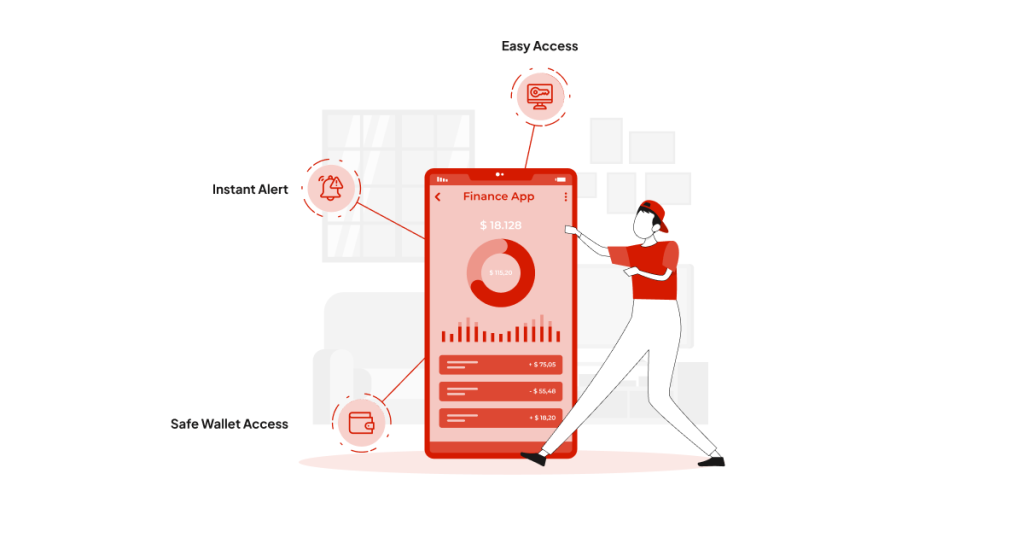
Mobile App Development is important for On-Chain Exchange Development. It lets users trade easily from their phones. Here are three ways mobile apps help:
- Easy Access:
Mobile apps let users trade anytime and anywhere. They can check their trades and portfolio on the go. - Instant Alerts:
Mobile apps send quick alerts about price changes and trades. This helps users stay up-to-date. - Safe Wallet Access:
Mobile apps connect to crypto wallets. This makes it easy and safe to store and manage assets while trading.
Technological Innovations Enhancing On-Chain Exchange Development
New technology is making On-Chain Exchange Development better. It helps exchanges work faster and be safer.
- Layer-2 Scaling Solutions:
Layer-2 solutions make trades faster and cheaper. They can handle more trades without slowing down the system. - DeFi Integration:
DeFi tools are improving. They can be used on on-chain exchanges for things like lending and staking. - Improved Smart Contracts:
Smart contracts are safer now. New updates make them harder to hack.
Regulatory Landscape and Compliance
The rules for cryptocurrency are changing fast. On-Chain Exchange Development must follow these rules to work well.
- Global Regulations:
Countries are making new rules for crypto exchanges. These rules affect how exchanges work. It is important to follow them. - KYC/AML Requirements:
Exchanges must follow KYC (know-your-customer) and AML (anti-money-laundering) rules. These rules help stop bad activities and keep users safe. - Tax Compliance:
Exchanges need to follow tax rules. This helps avoid problems with the law later.
Future Outlook and Opportunities
The future of On-Chain Exchange Development looks bright. As technology gets better, exchanges will also get better.
- DeFi Growth:
DeFi is growing fast. More people will use on-chain exchanges. This will bring more users. - Better User Experiences:
New technology will make exchanges easier to use. This will bring more people to use them. - Wider Use of Blockchain:
Blockchain will be used in more areas. As it grows, on-chain exchanges will grow too. More people will trust them.
Cost and Time to Build an On-Chain Exchange
| Aspect | Estimated Range |
|---|---|
| Time to Develop | 6 months to 1 year |
| Cost to Develop | $50,000 to $200,000+ |
When planning to build an on-chain exchange, it’s important to think about how much it will cost and how long it will take. Here are some things that affect the cost and time:
1. Choosing the Blockchain
The blockchain you pick can change the price. Some blockchains, like Ethereum, can be more expensive, while others may cost less.
2. Platform Features
A simple exchange will take less time and money to build. But if you want extra features, like advanced security or special tools, it will cost more and take longer.
3. Hiring Developers
If you hire experienced developers, the cost may be higher, but they will do a better job and finish faster. Working with a development team like Pyramidion can help speed up the process.
4. Security
Adding strong security features, like audits and multi-signature wallets, is important but can raise the cost.
5. Testing and Launch
Testing your platform to fix bugs and ensure it works properly can take extra time and money.

Conclusion
To wrap things up, On-Chain Exchange Development is a safe and easy way to build trading platforms. By choosing the right blockchain, keeping it secure, and making it simple for users, you can create a great exchange.
It is a great opportunity in the world of decentralized finance. If you’re ready to start, Pyramidions can help you build your on-chain exchange. Contact Us today to start your project!

Being the COO of Pyramidion Solutions, I am a passionate thought leader with 10+ years of industry experience in having helped multiple clients from all around the world complete their digital transformation journey.
I aim to ensure that my company is well-equipped to successfully navigate the ever-evolving digital landscape comprising emerging technologies like Data Science, Blockchain, Metaverse, and Web3.

